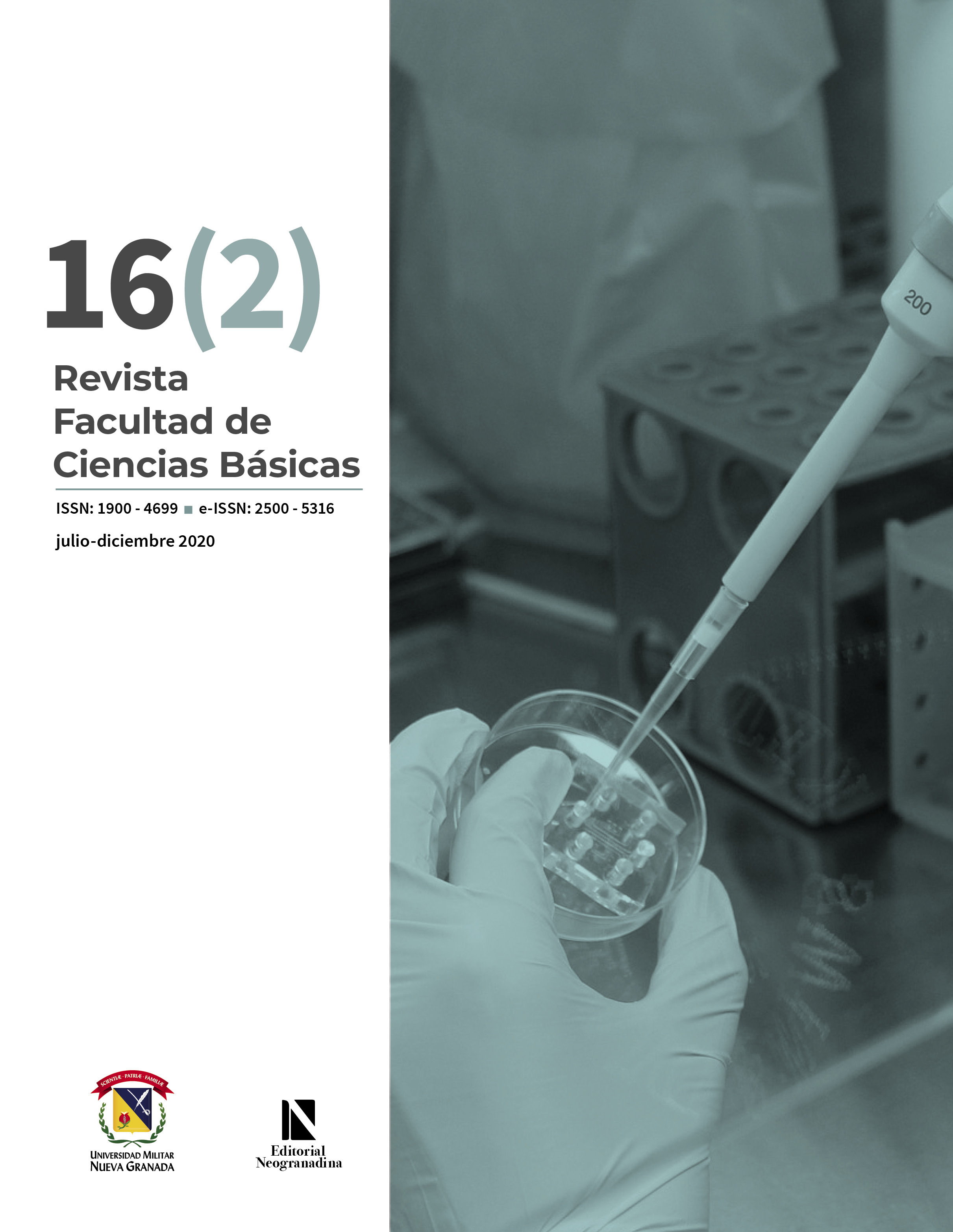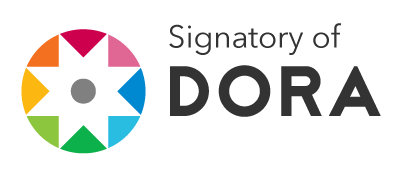Population Structure and Catasetum Ochraceum Pollinating Agents in the Western Mountain Range Cliffs (La Vorágine, Colombia)
Abstract
Catasetum ochraceum is a terrestrial orchid with discontinuous distribution in Colombia and Venezuela. A population was monitored for four years in La Vorágine, Valle del Cauca, Colombia. Pollination observations were made, as well as a census of individuals in the population was carried out. Catasetum spp is known to be pollinated by male euglossine bees, so to identify local pollinators, traps were located with attractants 1-8 cineol and methyl salicylate to collect bees with Catasetum polynaries. A total of 50 individuals were recorded, measured and mapped for follow-up from 2016 to 2020. During the observation period, no marked plants produced fruit and 22 plants survived until the end of the sampling. As for the collection of bees, 18 specimens of eight different species were recorded: Eulema nigrita, Exaerete smaragdina, Euglossa despecta, Eg. ignita, Eg. modestior, Eg. tridentata, Eg. deceptrix and Eg. liopoda. From these, Eg. deceptrix and Eg. liopoda carried polynaries of C. ochraceum. Therefore it is concluded that this population of orchids could be threatened, but the reasons for the population decline are unknown. In addition, two potential pollinator species are identified in the study area.
Downloads
References
K. Faegri y L.Van der Pijl, Principles of pollination ecology. Oxford: Elsevier, 2013.
C. A. Kearns, D. W. Inouye y N. M. Waser, "Endangered mutualisms: the conservation of plant-pollinator interactions", Annu Rev Ecol Evol Syst. Vol. 29, n.º 1, pp. 83-112, 1998. https://doi.org/10.1146/annurev.ecolsys.29.1.83
C. R. Darwin, The various contrivances by which orchids are fertilized by insects, 2a ed., London: John Murray, 1877. https://doi.org/10.5962/bhl.title.57232
L. Van Der Pijl y C. H. Dodson, Orchid flowers: their pollination and evolution, Coral Gables, Florida: Fairchild Tropical Garden and the University of Miami Press, 1966.
N. A. Van Der Cingel, An atlas of orchid pollination: European orchids, Roterdam: CRC Press, 2001.
R. L. Tremblay, "Trends in the pollination ecology of the Orchidaceae: evolution and systematics", Can J Bot. Vol. 70, n.º 3, pp. 642-650, 1992. https://doi.org/10.1139/b92-083
R. L. Dressler, "Biology of the orchid bees (Euglossini)", Annu Rev Ecol Evol Syst. Vol. 13, pp. 373-394,1982. https://doi.org/10.1146/annurev.es.13.110182.002105
G. Gerlach, "La pesadilla de Lindley-La biología sexual de Catasetum y Cycnoches", Lankesteriana. Vol 13, n.º 1-2, pp. 39-46, 2013. https://doi.org/10.15517/lank.v0i0.11532
D. W. Roubik y P. E. Hanson, Abejas de orquídeas de la América tropical: Biología y guía de campo, San Jose: Editorial INBio, 2004.
S. A Cameron, "Phylogeny and biology of Neotropical orchid bees (Euglossini)", Annu Rev Entomol. Vol. 49, pp. 377-404, 2004. https://doi.org/10.1146/annurev.ento.49.072103.115855
R. L. Dressler, "Pollination by euglossine bees", Evolution. Vol. 22, n.º 1, pp. 202-210, 1968. https://doi.org/10.1111/j.1558-5646.1968.tb03463.x
J. T. Otero."Biología de Euglossa nigropilosa Moure (Apidae: Euglossinae) I: características de nidificación en la Reserva Natural La Planada", Bol Mus Entom Uni Vall Vol. 4, n.º 1, pp. 1-19, 1996.
J. T. Otero, P. Ulloa-Chacón, P. A. Silverstone-Sopkin y T. Giray, "Group nesting and individual variation in behavior and physiology in the orchid bee Euglossa nigropilosa Moure (Hymenoptera, Apidae)", Insectes Soc. Vol. 55, n.º 3, pp. 320-328, 2008. https://doi.org/10.1007/s00040-008-1009-2
C. H. Dodson, R. L., Dressler, H. G. Hills, R. M.Adams y N. H. Williams, "Biologically active compounds in orchid fragrances", Science. Vol.164, n.º 3885, pp. 1243-1249, 1969. https://doi.org/10.1126/science.164.3885.1243
J. T. Otero y J. C. Sandino, "Capture Rates of Male Euglossine Bees across a Human Intervention Gradient, Chocó Region, Colombia", Biotropica. Vol.35, n.º 4, pp. 520-529, 2003. https://doi.org/10.1111/j.17447429.2003.tb00608.x
J. D. Ackerman, "Diversity and seasonality of male euglossine bees (Hymenoptera: Apidae) in Central Panama", Ecology. Vol. 64, n.º 2, pp. 274-283, 1983. https://doi.org/10.2307/1937075
C. M. S de Brito y M. M. C. Rêgo, "Community of male Euglossini bees (Hymenoptera: Apidae) in a secondary forest, Alcântara, MA, Brazil", Braz J Biol. Vol. 61 n.º 4, pp. 631-638, 2001. https://doi.org/10.1590/S1519-69842001000400012
D. W. Roubik y J. D. Ackerman, "Long-term ecology of euglossine orchid-bees (Apidae: Euglossini) in Panama", Oecologia. Vol. 73, n.º 3, pp. 321-333, 1987. https://doi.org/10.1007/BF00385247
F. S. Silva y J. M. M. Rebêlo, "Population dynamics of Euglossinae bees (Hymenoptera, Apidae) in an early second-growth forest of Cajual Island, in the state of Maranhão, Brazil", Braz J Biol. Vol. 62, n.º 1, pp. 15-23, 2002. https://doi.org/10.1590/S1519-69842002000100003
A. Tonhasca Jr, G. S. Albuquerque y J. L. Blackmer, "Dispersal of euglossine bees between fragments of the Brazilian Atlantic Forest", J Trop Ecol. Vol. 19 n.º 1, pp. 99-102, 2003. https://doi.org/10.1017/S0266467403003122
J. T. Otero y A. Sallenave, "Vertical stratification of euglossine bees (Hymenoptera: Apidae) in an Amazonian forest", Pan-Pac Entomol. Vol. 79, n.º 1, pp. 151-159, 2003.
L. A. Campos, F. A. D. Silveira, M. L. D Oliveira, C. V. Abrantes, E. F. Morato y G. A. de Melo, "Utilização de armadilhas para a captura de machos de Euglossini (Hymenoptera, Apoidea)", Rev Bras Zool. Vol. 6, n.º 4, pp. 621-626, 1989. https://doi.org/10.1590/S0101-81751989000400008
A. Nemsio y E. F. Morato, "The orchid-bee fauna (Hymenoptera: Apidae) of Acre state (northwestern Brazil) and a re-evaluation of euglossine bait-trapping", Lundiana. Vol 7, n.º 1, pp. 59-64, 2006.
J.P. Folsom, "Dos nuevas técnicas para capturar y marcar abejas machos de la tribu Euglossini (Hymenoptera: Apidae)", Actual Biol. Vol. 14, n.º 51, pp. 20-25, 1985.
J. C. Sandino, "Are there any agricultural effects on the capture rates of male euglossine bees (Apidae: Euglossini)?", Rev Biol Trop. Vol. 52, n.º 1, pp. 115-118, 2004. https://doi.org/10.15517/rbt.v52i1.14759
M. M. Bonilla, A. C. Aguirre, D. Yépez, E. Gallego y J.T. Otero, "Catasetum (Orchidaceae: catasetinae) en Colombia: Lista Actualizada", Rev Cienc Bás. Vol. 12, n.º 1, pp. 22-35, 2016. doi: 10.18359/rfcb.1851. https://doi.org/10.18359/rfcb.1851
G. A. Romero y C. E. Nelson, "Sexual dimorphism in Catasetum orchids: forcible pollen emplacement and male flower competition", Science. Vol. 232, n.º 4757, pp. 1538-1540, 1986. https://doi.org/10.1126/science.232.4757.1538
A. W. Holst, The world of Catasetums, Portland: Timber Press, 1999.
J. E. Orejuela, "Orchids of a regenerated tropical dry forest in the Cali river watershed, Municipality of Cali, Colombia", Lankesteriana. Vol. 7, n.º 1-2, pp. 71-82, 2007. https://doi.org/10.15517/lank.v7i1-2.18443
G. A. Reina-Rodríguez y J. T. Otero, Guía ilustrada de las orquídeas del Valle Geográfico del río Cauca y Piedemonte Andino Bajo, Santiago de Cali: Sociedad Vallecaucana de Orquideología, 2011.
G. A. Reina-Rodríguez, N. H. Ospina-Calderón, A. Castaño, I. Soriano y J. T. Otero, "Catálogo de las orquídeas del Valle geográfico del río Cauca y su piedemonte andino bajo, Sur-occidente colombiano", Cespedesia. Vol. 32, n.º 90-91, pp. 7-22, 2010.
G. A. Reina-Rodríguez, J. E. Rubiano, F. A. C. Llanos y J. T. Otero, "Spatial distribution of dry forest orchids in the Cauca River Valley and Dagua Canyon: towards a conservation strategy to climate change", J Nat Conserv. Vol. 30, n.º 1, pp. 32-43, 2016. https://doi.org/10.1016/j.jnc.2016.01.004
H. G. Hills, N. H. Williams y C. H. Dodson, "Floral fragrances and isolating mechanisms in the genus Catasetum (Orchidaceae)", Biotropica. Vol. 4, n.º 2, 61-76, 1972. https://doi.org/10.2307/2989728
M. A. Bonilla-Gómez y G. Nates-Parra, "Abejas euglosinas de Colombia (Hymenoptera: Apidae) I. Claves ilustradas", Caldasia. Vol. 17, n.º 1, pp. 149-172, 1992. https://doi.org/10.15446/caldasia
Ø. Hammer, D. A. T. Harper y P. D. Ryan, "past: paleontological Statistics Software Package for Education and Data Analysis", Palaeontol Electronica. Vol. 4 n.º 1, pp. 1-9, 2001.
R. Zucchi, S. F. Sakagami y J. M. de Camargo. "Biological Observations on a Neotropical Parasocial Bee, Eulaema nigrita, with a Review on the Biology of Euglossinae (Hymenoptera, Apidae): A Comparative Study", J Fac Sc Hok U, series. Zoology. Vol. 17, n.º 2, pp. 271-380, 1969.
M. L. Santos y C. A. Garófalo, "Nesting biology and nest re-use of Eulaema nigrita (Hymenoptera: Apidae, Euglossini)", Insectes Soc. Vol. 41, n.º 1, pp. 99-110, 1994. https://doi.org/10.1007/BF01240577
D. H. Janzen, P. J. deVries, M. L. Higgins y L. S. Kimsey, "Seasonal and site variation in Costa Rican euglossine bees at chemical baits in lowland deciduous and evergreen forests", Ecology. Vol. 63, n.º 1, pp. 66-74, 1982. https://doi.org/10.2307/1937032
J. D. Ackerman, A. M., Montalvo, "Longevity of euglossine bees", Biotropica. Vol. 17, n.º 1, pp. 79-81, 1985. https://doi.org/10.2307/2388384
S. C. Ramírez, R. L. Dressler y M. Ospina, "Abejas euglosinas (Hymenoptera: Apidae) de la Región Neotropical: Listado de especies con notas sobre su biología", Biota colomb. Vol. 3, n.º 1, pp. 7-118, 2002.
R. B. Singer y S. Koehler, "Notes on the pollination biology of Notylia nemorosa (Orchidaceae): do pollinators necessarily promote cross pollination?", J Plant Res. Vol. 116, n.º 1, pp. 19-25, 2003. https://doi.org/10.1007/s10265-002-0064-4
C. H. Dodson y H. G. Hills, "Gas chromatography of orchid fragrances", American Orchid Society Bulletin. Vol. 35, n.° 1, pp. 720-725, 1966.
C. H. Dodson, "Dressleria and Clowesia: a new genus and an old one revived in the Catasetinae (Orchidaceae)", Selbyana. Vol. 1, n.º 2, pp. 130-137, 1975.
R. L. Dressler, "Why do euglossine bees visit orchid flowers", Atas do simpósio sôbre a biota amazônica. Vol. 5, pp. 171-180, 1967.
R. L. Dressler, "How to study orchid pollination without any orchids", en Proceedings of the Eighth World Orchid Conference, K. Senghas, Ed. Frankfurt: German Orchid Society, pp. 534-537, 1976.
D. W. Roubik, Ecology and natural history of tropical bees, Cambridge: Cambridge University Press, 1992.
J. D. Ackerman, "Euglossine bee pollination of the orchid, Cochleanthes lipscombiae: a food source mimic", Am J Bot. Vol. 70, n.º 6, pp. 830-834, 1983. https://doi.org/10.2307/2442934
R. L. Dressler, "Observations on orchids and euglossine bees in Panama and Costa Rica", Rev Biol Trop. Vol. 15 n.º 1, pp. 143-183, 1968.
C. H. Dodson, "Pollination and variation in the subtribe Catasetinae (Orchidaceae)", Ann Mo Bot Gard. Vol. 49, n.º 1/2, pp. 35-56, 1962. https://doi.org/10.2307/2394740
C.A. Garófalo y J. G. Rozen Jr.,"Parasitic behavior of Exaerete smaragdina with descriptions of its mature oocyte and larval instars (Hymenoptera: Apidae: Euglossini)", Am Mus Novit. N.º 3349, pp. 1-28, 2001. https://doi.org/10.1206/0003-0082(2001)349<0001:PBOESW>2.0.CO;2
A. Nemesio, "Orchid bees (Hymenoptera: Apidae) of the Brazilian Atlantic Forest", Zootaxa. Vol. 2041 n.º 1, pp. 1-242, 2009. https://doi.org/10.11646/zootaxa.2041.1.1
D. L. Pearson y R. L. Dressler, "Two-year study of male orchid bee (Hymenoptera: Apidae: Euglossini) attraction to chemical baits in lowland south-eastern Peru" J Trop Ecol. Vol.1, n.º 1, pp. 37-54, 1985. https://doi.org/10.1017/S0266467400000067
L. S. Kimsey, "An illustrated key to the genus Exaerete with descriptions of male genitalia and biology (Hymenoptera: Euglossini, Apidae)", J Kans Entomol Soc. Vol. 52, n.º 4, pp. 735-746, 1979.
N. H. Williams y W. M. Whitten, "Orchid floral fragrances and male euglossine bees: methods and advances in the last sesquidecade", Biol Bull. Vol. 164, n.º 3, pp. 355-395, 1983. https://doi.org/10.2307/1541248
R. B., Singer y M. Sazima. "Flower morphology and pollination mechanism in three sympatric Goodyerinae orchids from southeastern Brazil", Ann Bot. Vol. 88, n.º 6, pp. 989-997, 2001. https://doi.org/10.1006/anbo.2001.1534
C. H. Dodson, "The Catasetums (Orchidaceae) of Tapakuma, Guyana", Selbyana. Vol. 2, n.º 2/3, pp. 159- 168, 1978.
C. H. Dodson, "Ethology of some bees of the tribe Euglossini (Hymenoptera: Apidae)", J Kans Entomol Soc. Vol. 39, n.º 4, pp. 607-629, 1966.
A. H. Gentry y C. H. Dodson, "Diversity and biogeography of neotropical vascular epiphytes", Ann Mo Bot Gard. Vol. 74, n.º 2, pp. 205-233, 1987. https://doi.org/10.2307/2399395











